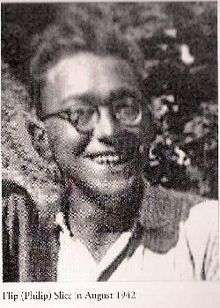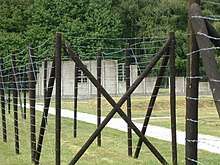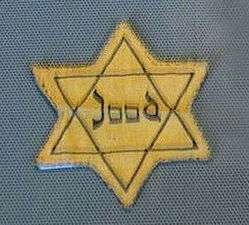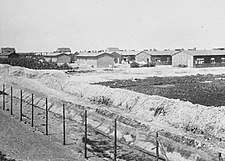Philip Slier
Philip "Flip" Slier (4 December 1923 – 9 April 1943) was a Jewish Dutch typesetter who lived in Amsterdam during the German occupation of the Netherlands in World War II. Slier left documentation of his experiences as a forced labourer in the Molengoot labor camp in a series of 86 letters that he wrote to his parents between April and September 1942. His family concealed his letters in their Amsterdam house, where they were discovered more than 50 years later.[1][2]
Flip Slier | |
|---|---|
 Flip Slier in 1942 | |
| Born | Philip Slier 4 December 1923 |
| Died | 9 April 1943 (aged 19) |
| Occupation | Typographer |
Early life
Philip Slier (rhymes with "beer") was born on 4 December 1923 in Amsterdam, Netherlands, on the top floor in their third floor apartment, at 128 Vrolikstraat. To his friends and family, Philip was known as "Flip".[3][4][5]
Demeanor and physical description
His best friend, Karel van der Schaaf, describes his demeanor as brutaal - an uninhibited, extremely daring and bold but good-natured teenager with a sense of humor, who liked being around others.[6] Deborah Slier, editor of reference book Hidden Letters and Flip's cousin,[3] says his letters show him to be "likeable, optimistic, humorous, and affectionate".[5] He had a musical inclination as he liked singing and he played the flute and mandolin.[6] Another of his hobbies was photography, for which he had a passion.[7]
As a teenager, he was "5 feet 7 3/4 inches tall, weighed 156 lbs, had black hair and gray eyes".[6]
Teenage years
Flip’s first girlfriend, Truus Sant, played the drums in a musical band called the AJC band - "Arbeiders Jeugd Centrale" (Worker's Youth Center). He played the flute in the band.[6] Flip’s parents did not approve of her because he was Jewish, and she was Christian.[6] The Germans invaded the Netherlands in 1940, when Flip was 17.[8]
Road to death

On 23 April 1942, when Flip was 18, he received a notice with instructions to board a train to a labor camp. The instructions came from the Jewish Council of Amsterdam, under orders from the German occupiers, who threatened dire consequences (arrest) if the notice was ignored. He went to Camp Molengoot[9] (English: "mill gutter"), where he was forced to perform hard labor under harsh conditions.[10] The camp was at Collendoorn, a small settlement just north of Hardenberg.[11] The work entailed digging a canal for a mill flume, a mill gutter.[12] From Molengoot, Flip wrote to friends and his family almost daily, giving an eyewitness account of life in the camp with his dozens of letters. [3][13] Camp Molengoot was to be closed, and the prisoners were to be sent off to Westerbork transit camp (essentially a temporary detention holding area) on 3 October, Yom Kippur.[3]
It is possible that Flip heard of the fate of the Jews in the camp (dying at another camp), wrote his last letter on 14 September 1942 and then escaped from the camp.[14] Flip went to Amsterdam. He was an onderduiker (literally "under-diver", a person hiding from the Germans) and many times protected by others (farmers and families).[13] Flip was offered protection and shelter by Karel van der Schaaf's brother, Jo, who lived only 2 blocks away from Flip's parents and lived on Vrolik Street. He was able to visit his parents often by using fake papers and changing his physical appearance.[14]
Flip moved to different hiding locations in Amsterdam from time to time, as most onderduikers did to prevent detection by the Germans. Sometime around February 1943, Karel van der Scaaf (Flip's close friend) made arrangements with someone in Bussum or Hilversum for Flip's escape to Switzerland. However, on 3 March 1943 Flip was caught and arrested by the Germans at the Amsterdam Centraal railway station when he was trying to board a train to Switzerland. It is unknown who may have told the Germans of Flip's escape plans, but the contact in Bussum (or Hilversum) was later considered "untrustworthy".[15]

The given reason for Flip's arrest on the official arrest record was Ohne Stern ("without a star", not wearing a yellow star badge on his outer clothing indicating he was a Jew, as was required by the Germans).[15] He was apprehended and transported to Vught concentration camp, North Brabant, in the south of the Netherlands.[15] A questionnaire for the prisoners indicated that Flip put up some resistance when he was apprehended to go to Vught, as it said that he had scars on his lip.[16]
The Germans in occupied Netherlands ordered that all Jews over the age of 6 had to wear a six pointed yellow star symbol on their outer clothing, for easy identification, to be the size of a saucer. The black lettering of "jood" (Dutch for Jew) had to be in the middle. Punishment for Jews not wearing one was severe, such as deportation to a concentration camp.[17][18]
Flip's time at Vught concentration camp was very harsh, as for all other prisoners.[15] The conditions were so bad that some prisoners thought that conditions in Poland could not be as bad as they were in Vught. One prisoner commented, "Things surely can't be as bad in Poland as they are at Vught. It's hell, sheer hell!"[19] Vught concentration camp, run by the SS, held 18,000 people, mostly Jews but also some political and resistance prisoners.[15]

Flip was transferred to Westerbork concentration camp on 31 March 1943, where he was put into a punishment barrack.[15]
On 6 April 1943 Flip, with many of his friends and relatives, were loaded into a railroad cattle cars shipped from Westerbork to Sobibor extermination camp.[20] There were 2020 prisoners shipped to Sobibor on Flip's train.[20] They arrived at the extermination camp on 9 April 1943.[21] Upon their arrival, they were killed by gas.[21]
Flip's parents were arrested on 24 May 1943 and transferred to Westerbork concentration camp. On 1 June 1943 they, along with 3,000 others, were loaded into railroad cattle cars for Poland to the Sobibor extermination camp.[20] They were both killed on 4 June 1943.[22]
Of the 58 immediate members of the Slier family in the Netherlands at the beginning of the war, only 6 were alive at the end of the war. Less than 25% of the Netherlands' Jewish population survived World War II.[23]
Hidden letters
Flip wrote 86 letters, including postcards and a telegram, and since the publication of Hidden Letters, more have been found. He wrote these to his family and to friends from Molengoot, where he was taken. He sent letters almost daily from April to September 1942. They show an insight into the life at the camps. Flip wished his letters to be saved and asked his parents to hide them away.[3][24]
In 1997, the house at 128 Vrolikstraat, Amsterdam, where Flip had lived with his parents, was being demolished. The foreman of the demolition company came upon Flip's letters hidden in the ceiling of the third floor bathroom. He found 86 letters and postcards and a telegram. The foreman thought that the papers could be important and kept them for two years. He then turned them over to the National Institute of War Documentation (NIOD: National Instituut voor Oorlogs Documentie, now Instituut voor oorlogs; holocaust and genocide studies). He was hoping that eventually, he would learn the fate of the boy who wrote the letters.[3]
An expert on Anne Frank at NIOD could see the significance in Flip's letters and passed them onto a journalist. She published the hidden letters in an article on her own on the camps in the Journal Vrij Nederland, where she worked. The hidden letters eventually came into the possession of Flip's cousin in 1999. She, in turn, did extensive research follow up and produced a book called Hidden Letters, a comprehensive study on Flip's letters.[3][25]
References
- Slier & Slier 2008, p. 11, 25.
- Rappaport & Widerman, p. 22.
- Slier & Slier 2008, p. 11.
- Slier & Slier 2008, p. 10.
- Rappaport & Widerman, p. 3.
- Slier & Slier 2008, p. 25.
- Rappaport & Widerman, p. 4.
- Slier & Slier 2008, p. 16.
- "Mill gutter". Archived from the original on 2012-05-30. Retrieved 2012-11-26.
- Slier & Slier 2008, p. 30, 31.
- Slier & Slier 2008, p. 19.
- Slier & Slier 2008, p. 30.
- Slier & Slier 2008, p. 12.
- Slier & Slier 2008, p. 140.
- Slier & Slier 2008, p. 144.
- Slier & Slier 2008, p. 145.
- Slier & Slier 2008, p. 36.
- "Holocaust Encyclopedia - Describes restrictions on Jews in Amsterdam, including the yellow star". Retrieved 2012-11-26.
- According to Hidden Letters Notes and Sources p. 171; Philip Mechanicus (1964 p. 95) was quoting a prisoner who had just arrived at Westbrook from Vught in July 1943
- Slier & Slier 2008, p. 146.
- Slier & Slier 2008, p. 150.
- Slier & Slier 2008, p. 159.
- Slier & Slier 2008, p. 158.
- Rappaport & Widerman, p. 3-4.
- "Amazon books - book review of Hidden Letters". Retrieved 2012-11-26.
Bibliography
- Rappaport, Ellen; Widerman, Rivka, Teacher's Guide (PDF), Star Bright BooksCS1 maint: ref=harv (link)
- Slier, Philip; Slier, Deborah (2008), Hidden Letters (illustrated ed.), New York: Star Bright Books, ISBN 1887734880CS1 maint: ref=harv (link)